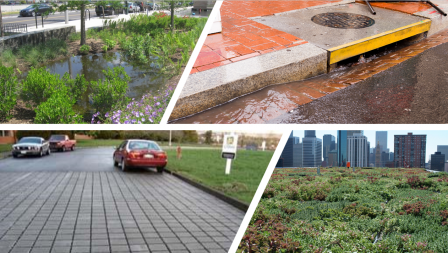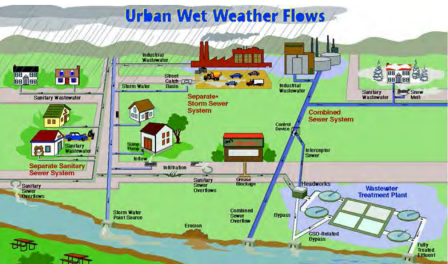Storm Water Management Model (SWMM)
Helps predict runoff quantity and quality from drainage systems
On this Page
- Software, Compatibility, and Manuals
- Capabilities
- Applications
- Green Infrastructure as LID Controls
- Related Resources
- Technical Support
Disclaimer: Any mention of trade names, manufacturers, or products does not imply an endorsement by EPA. EPA and its employees do not endorse commercial products, services, or enterprises.
EPA's Storm Water Management Model (SWMM) is used throughout the world for planning, analysis, and design related to stormwater runoff, combined and sanitary sewers, and other drainage systems. It can be used to evaluate gray infrastructure stormwater control strategies, such as pipes and storm drains, and is a useful tool for creating cost-effective green/gray hybrid stormwater control solutions. SWMM was developed to help support local, state, and national stormwater management objectives to reduce runoff through infiltration and retention, and help to reduce discharges that cause impairment of waterbodies.
Software, Compatibility, Manuals, and Other Documents
SWMM is a Windows-based desktop program. It is open source public software and is free for use worldwide. SWMM 5 was produced in a joint development effort with CDM, Inc., a global consulting, engineering, construction, and operations firm.
Software
|
Date |
Description |
|---|---|
| 7/20/2020 | Self-Extracting Installation Program for SWMM 5.1.015 (EXE)(32 MB) |
| 02/18/2020 | Self-Extracting Installation Program for SWMM 5.1.014 (EXE)(31 MB) |
| 12/11/2014 | SWMM-CAT Download Version 1(4 MB) |
| 05/25/2005 | Utility for converting SWMM 4 data files to SWMM 5 files (EXE) Version 1.2(2 MB) |
Source Codes and Bug Fixes
|
Date |
Description |
|---|---|
| 7/20/2020 | SWMM 5.1.015 Updates and Bug Fixes (TXT)(140 K) |
| 7/20/2020 | Source Code for the SWMM 5.1.015 Computational Engine (ZIP)(379 K) |
| 7/20/2020 | Source code for the SWMM 5.1.015 Graphical User Interface (ZIP)(1 MB) |
| 02/18/2020 | SWMM 5 Updates and Bug Fixes (TXT)(138 K) |
| 03/16/2020 | Source Code for the SWMM 5.1.014 Computational Engine (ZIP)(369 K) |
| 02/18/2020 | Source code for the SWMM 5.1.014 Graphical User Interface (ZIP)(2 MB) |
Manuals and Guides
| Date | Title |
|---|---|
| 09/30/2015 | SWMM 5.1 User’s Manual |
| 09/01/2014 | SWMM-CAT User's Guide |
| 09/07/2016 | SWMM Applications Manual (ZIP)(7 MB) |
| 01/18/2018 | SWMM Modeling Methods for Simulating Green Infrastructure at a Suburban Headwatershed: User's Guide |
| 03/19/2019 | SWMM Reference Manuals Errata (Volumes I and II) |
| 01/29/2016 | SWMM Reference Manual Volume I—Hydrology |
| 08/07/2017 | SWMM Reference Manual Volume II—Hydraulics |
| 09/08/2016 | SWMM Reference Manual Volume III—Water Quality (Includes the LID Module references) |
Other Documents
| Date | Title |
|---|---|
| 10/30/2018 | Open Source SWMM: Community-Based Software Development for Stormwater Management Modeling |
| 09/19/2006 | Quality Assurance Report for Dynamic Wave Flow Routing (ZIP)(3 MB) |
Capabilities
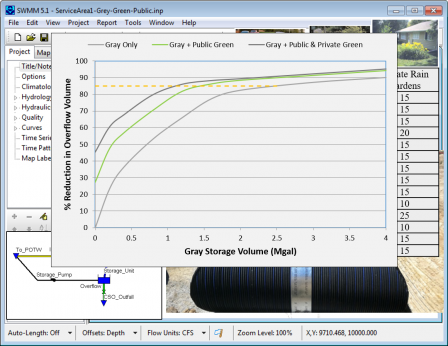 SWMM is used for single event or long-term simulations of water runoff quantity and quality in primarily urban areas—although there are also many applications that can be used for drainage systems in non-urban areas. SWMM provides an integrated environment for editing study area input data, running hydrologic, hydraulic and water quality simulations, and viewing the results in a variety of formats. These include color-coded drainage area and conveyance system maps, time series graphs and tables, profile plots, and statistical frequency analyses.
SWMM is used for single event or long-term simulations of water runoff quantity and quality in primarily urban areas—although there are also many applications that can be used for drainage systems in non-urban areas. SWMM provides an integrated environment for editing study area input data, running hydrologic, hydraulic and water quality simulations, and viewing the results in a variety of formats. These include color-coded drainage area and conveyance system maps, time series graphs and tables, profile plots, and statistical frequency analyses.
Hydraulic Modeling
SWMM contains a flexible set of hydraulic modeling capabilities used to route runoff and external inflows through the drainage system network of pipes, channels, storage/treatment units and diversion structures. These include the ability to do the following:
- Handle drainage networks of unlimited size.
- Use a wide variety of standard closed and open conduit shapes as well as natural channels.
- Model special elements, such as storage/treatment units, flow dividers, pumps, weirs, and orifices.
- Apply external flows and water quality inputs from surface runoff, groundwater interflow, rainfall-dependent infiltration/inflow, dry weather sanitary flow, and user-defined inflows.
- Utilize either kinematic wave or full dynamic wave flow routing methods.
- Model various flow regimes, such as backwater, surcharging, reverse flow, and surface ponding. apply user-defined dynamic control rules to simulate the operation of pumps, orifice openings, and weir crest levels.
- Percolation of infiltrated water into groundwater layers.
- Interflow between groundwater and the drainage system.
- Nonlinear reservoir routing of overland flow. Runoff reduction via LID controls.
Accounting for Hydrologic Processes
SWMM accounts for various hydrologic processes that produce runoff from urban areas, which include the following:
- Runoff reduction via green infrastructure practices.
- Time-varying rainfall (precipitation) and evaporation of standing surface water.
- Snow accumulation and melting.
- Rainfall interception from depression storage.
- Infiltration of rainfall into unsaturated soil layers.
- Percolation of infiltrated water into groundwater layers Interflow between groundwater and the drainage system.
- Nonlinear reservoir routing of overland flow.
Spatial variability in all of these processes is achieved by dividing a study area into a collection of smaller, homogeneous sub-catchment areas. Each of the areas contains its own fraction of pervious and impervious sub-areas. Overland flow can be routed between sub-areas, between sub-catchments, or between entry points of a drainage system.
Pollutant Load Estimation
SWMM can estimate the production of pollutant loads associated with stormwater runoff. The following processes can be modeled for any number of user-defined water quality constituents:
- Dry-weather pollutant buildup over different land uses.
- Pollutant wash-off from specific land uses during storm events.
- Direct contribution of rainfall deposition. Reduction in dry-weather buildup due to street cleaning.
- Reduction in wash-off load due to best management practices (BMPs).
- Entry of dry weather sanitary flows and user-specified external inflows at any point in the drainage system.
- Routing of water quality constituents through the drainage system.
- Reduction in constituent concentration through treatment in storage units or by natural processes in pipes and channels.
Add-in Tool for Climate Projections
SWMM includes a software utility that allows future climate change projections to be incorporated into modeling. The SWMM Climate Adjustment Tool (SWMM-CAT) provides a set of location-specific adjustments derived from World Climate Research Programme global climate change models. SWMM-CAT accepts monthly adjustment factors for climate-related variables that could represent the potential impact of future climate changes.
Applications
- Designing and sizing of drainage system components for flood control.
- Sizing detention facilities and their appurtenances for flood control and water quality protection.
- Mapping flood plains of natural channel systems—SWMM 5 is a FEMA-approved model for National Flood Insurance Program studies.
- Designing control strategies for minimizing combined sewer overflows.
- Evaluating the impact of inflow and infiltration on sanitary sewer overflows.
- Generating nonpoint source pollutant loadings for waste load allocation.
- Controlling site runoff using green infrastructure practices as low LID controls.
- Evaluating the effectiveness of best management practices and low impact development for reducing wet weather pollutant loadings.
Green Infrastructure as LID Controls
SWMM allows engineers and planners to represent combinations of green infrastructure practices as low impact development (LID) controls to determine their effectiveness in managing runoff. Although some of these practices can also provide significant pollutant reduction benefits, at this time, SWMM only models the reduction in runoff mass load resulting from the reduction in runoff flow volume.
SWMM can explicitly model eight different generic green infrastructure practices: |
|
|---|---|
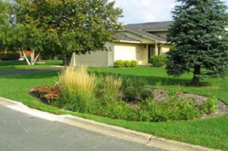 |
Rain Gardens Rain gardens are depressed areas, planted with grasses, flowers, and other plants, that collect rain water from a roof, driveway, or street and allow it to infiltrate into the ground. More complex rain gardens are often referred to as bioretention cells. |
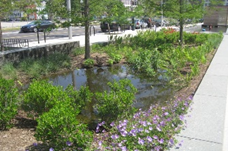 |
Bioretention Cells (or Bioswales) Bioretention cells are depressions containing vegetation grown in an engineered soil mixture placed above a gravel drainage bed that provide storage, infiltration, and evaporation of both direct rainfall and runoff captured from surrounding areas. |
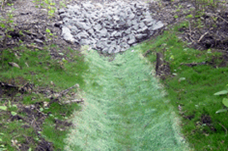 |
Vegetative Swales Vegetative swales are channels or depressed areas with sloping sides covered with grass and other vegetation that slow down the conveyance of collected runoff and allow it more time to infiltrate the native soil beneath it. |
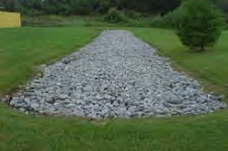 |
Infiltration Trenches Infiltration trenches are narrow ditches filled with gravel that intercept runoff from upslope impervious areas. They provide storage volume and additional time for captured runoff to infiltrate the native soil below |
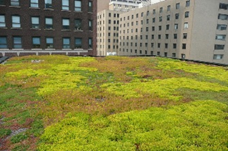 |
Green Roofs Green roofs are a variation of a bioretention cells that have a soil layer atop a special drainage mat material that conveys excess percolated rainfall off of the roof. They contain vegetation that enable rainfall infiltration and evapotranspiration of stored water. |
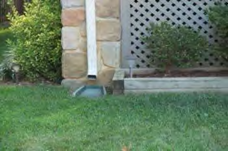 |
Rooftop (Downspout) Disconnection This practice allows rooftop rainwater to discharge to pervious landscaped areas and lawns instead of directly into storm drains. It can be used to store stormwater (e.g., in a rain barrel) and/or allow stormwater to infiltrate into the soil (e.g., into a rain garden or lawn). |
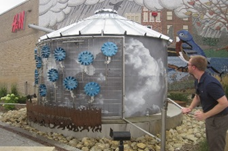 |
Rain Barrels or Cisterns (Rainwater Harvesting) Rain barrels and cisterns are containers that collect roof runoff during storm events and can either release or re-use the rainwater during dry periods. Cisterns may be located above or below ground and have a greater storage capacity than a rain barrel. |
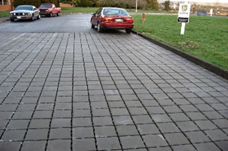 |
Continuous Permeable Pavement Systems Permeable pavement allows rainfall to immediately pass through the pavement into the gravel storage layer below where it can infiltrate at natural rates into the site's native soil. In block paver systems, rainfall is captured in the open spaces between the blocks and conveyed to the storage zone and native soil below. |
Related Resources
- SWMM Fact Sheet
- SWMM Publications in Science Inventory
- Green Infrastructure Modeling Toolkit
- Infiltration Models
- Water System Security and Resilience
Technical Support
- Questions or comments: Contact us about SWMM
- A SWMM users’ listserv, established by the University of Guelph, allows subscribers to ask questions and exchange information. To subscribe, send an email message with the words "subscribe swmm-users" in the subject line and your name in the body of the email. Subscription email: listserv@listserv.uoguelph.ca

